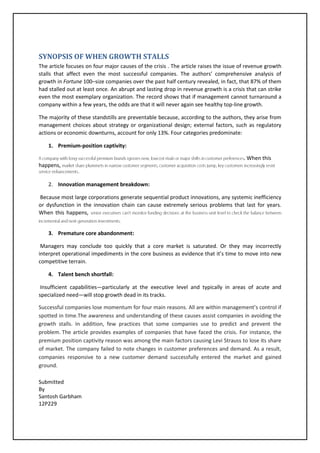Report
Share

Recommended
Recommended
More Related Content
Viewers also liked
Viewers also liked (9)
1 a sakowski_produkcja budowlana - stan aktualny i prognozy4

1 a sakowski_produkcja budowlana - stan aktualny i prognozy4
R05010501 B A S I C E L E C T R I C A L E N G I N E E R I N G

R05010501 B A S I C E L E C T R I C A L E N G I N E E R I N G
Gordon K. Strahl: Marketing in der Freien Kulturszene

Gordon K. Strahl: Marketing in der Freien Kulturszene
Similar to Sm assignment santosh
Similar to Sm assignment santosh (20)
A.T. Kearney: GCC Family Businesses: Unlocking Potential Through Active Portf...

A.T. Kearney: GCC Family Businesses: Unlocking Potential Through Active Portf...
Based on everything you know then, what is Bezos singular grand s.docx

Based on everything you know then, what is Bezos singular grand s.docx
Harvard Business School: Why Companies Fail and How Their Founders Can Bounce...

Harvard Business School: Why Companies Fail and How Their Founders Can Bounce...
Article - Innovation-aware-governance an enhanced framework for growth

Article - Innovation-aware-governance an enhanced framework for growth
© Strayer University. All Rights Reserved. This document conta

© Strayer University. All Rights Reserved. This document conta
BUS 499, Week 6 Acquisition and Restructuring StrategiesSlide #

BUS 499, Week 6 Acquisition and Restructuring StrategiesSlide #
BUS 499, Week 6 Acquisition and Restructuring StrategiesSlide #.docx

BUS 499, Week 6 Acquisition and Restructuring StrategiesSlide #.docx
Development criteria for companies in open markets

Development criteria for companies in open markets
More from Santosh Garbham
More from Santosh Garbham (14)
Sm assignment santosh
- 1. SYNOPSIS OF WHEN GROWTH STALLS The article focuses on four major causes of the crisis . The article raises the issue of revenue growth stalls that affect even the most successful companies. The authors’ comprehensive analysis of growth in Fortune 100–size companies over the past half century revealed, in fact, that 87% of them had stalled out at least once. An abrupt and lasting drop in revenue growth is a crisis that can strike even the most exemplary organization. The record shows that if management cannot turnaround a company within a few years, the odds are that it will never again see healthy top-line growth. The majority of these standstills are preventable because, according to the authors, they arise from management choices about strategy or organizational design; external factors, such as regulatory actions or economic downturns, account for only 13%. Four categories predominate: 1. Premium-position captivity: . When this happens, 2. Innovation management breakdown: Because most large corporations generate sequential product innovations, any systemic inefficiency or dysfunction in the innovation chain can cause extremely serious problems that last for years. When this happens, 3. Premature core abandonment: Managers may conclude too quickly that a core market is saturated. Or they may incorrectly interpret operational impediments in the core business as evidence that it’s time to move into new competitive terrain. 4. Talent bench shortfall: Insufficient capabilities—particularly at the executive level and typically in areas of acute and specialized need—will stop growth dead in its tracks. Successful companies lose momentum for four main reasons. All are within management’s control if spotted in time.The awareness and understanding of these causes assist companies in avoiding the growth stalls. In addition, few practices that some companies use to predict and prevent the problem. The article provides examples of companies that have faced the crisis. For instance, the premium position captivity reason was among the main factors causing Levi Strauss to lose its share of market. The company failed to note changes in customer preferences and demand. As a result, companies responsive to a new customer demand successfully entered the market and gained ground. Submitted By Santosh Garbham 12P229
